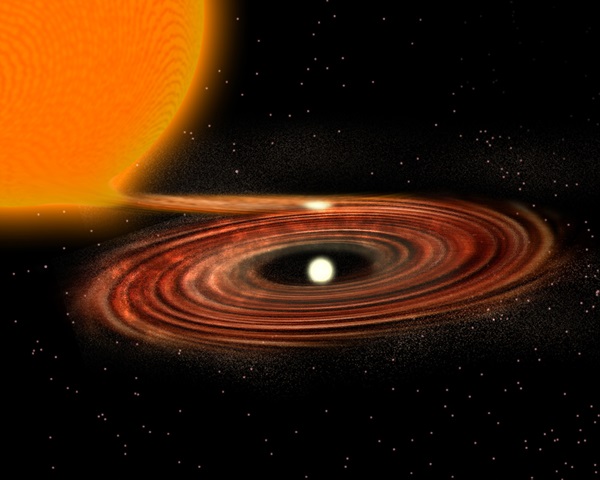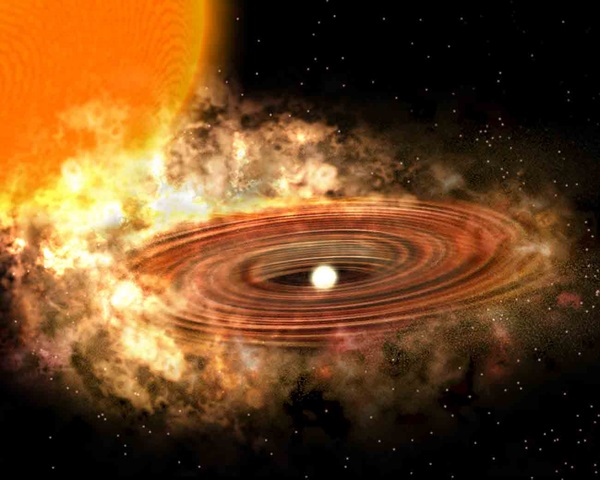Observations of the interacting binary star using telescopes at Kitt Peak National Observatory and NASA’s Spitzer Space Telescope suggest that the disks of hot gas that accumulate around a wide variety of astronomical objects, from degenerate stars in energetic binary systems to supermassive black holes at the hearts of active galaxies, are likely to be much larger than previously believed.
The target of this specific investigation, named WZ Sagittae (WZ Sge), is an interacting binary star located in the constellation Sagitta, the arrow of the archer Sagittarius. As part of a program called the Spitzer-NOAO Observing Program for Teachers and Students, Steve B. Howell and a team of astronomers and educators imaged WZ Sge using the National Science Foundation’s 2.1-meter telescope and the WIYN 0.9-meter telescope, both located at Kitt Peak, and the Infrared Array Camera (IRAC) on Spitzer.
“We were very surprised to see the contrasting results obtained with the optical telescopes on the ground and the infrared telescope in space,” says Howell, an astronomer at the National Optical Astronomy Observatory (NOAO) and leader of the team who made the discovery that was reported Wednesday in Austin, Texas, at the 211th meeting of the American Astronomical Society (AAS). “The much larger size of the infrared-emitting portion of the accretion disk around WZ Sge was immediately obvious in the data. Our observations strongly imply the presence of dark matter in these structures, which are ubiquitous throughout the universe.”
Interacting binary stars such as WZ Sge contain a white dwarf star (a compact star about the size of the Earth, but with a mass near that of the Sun) and a larger, but less massive and much cooler companion star. The companion, usually a low-mass star or a brown dwarf, has material ripped off its surface by the stronger gravity of the white dwarf. This material flows toward the more massive star and, in the process, forms a disk surrounding the white dwarf, known as an accretion disk.
Whether they form in cataclysmic variable systems or they surround the massive black hole hearts of active galaxies, accretion disks have been well observed and modeled using measurements obtained across much of the electromagnetic spectrum, from X-rays to the near-infrared. The derived picture of the “standard accretion disk” model is a geometrically thin disk of gaseous material surrounding the white dwarf or black hole. Accretion disk models, bolstered by observation, are generally composed of hot gas having a temperature distribution within them, being hottest near the center and falling off in temperature toward the outer edge.
In order to confirm the general accretion disk models and extend them into the mid-infrared portion of the spectrum, Howell’s team obtained the first time series observations of an accretion disk system at 4.5 and 8 microns with the Spitzer Space Telescope. At nearly the same time, they obtained optical observations of WZ Sge at Kitt Peak. The optical observations confirmed the standard view of the accretion disk size and temperature, values known for over a decade.
The mid-infrared observations, however, were completely unexpected and revealed that a larger, thicker disk of cool dusty material surrounds much of the gaseous accretion disk. This outer dust disk likely contains as much mass as a medium-sized asteroid. The newly discovered outer disk extends about 20 times the radius of the gaseous disk.
“This discovery suggests that our current model for accretion disks of all kinds is wrong,” says team member Donald Hoard of the Spitzer Science Center. “We will need to rethink and recast these models for accretion disks, not only in interacting binary stars but also in distant, highly luminous active galaxies.”
The implications from such a discovery are far reaching, affecting not only the theoretical models (since the formation and evolution of the disks are modeled based on their size, temperature, and composition-all quantities that now need to be revised), but also nearly all previous observations of systems containing accretion disks.
In addition, the dust disk (which is thicker than the known gaseous disk) blocks infrared light emitted by the compact central object and the inner hot regions of the gaseous disk. Not knowing that some mid to far infrared light is blocked by the newly discovered outer dust ring can lead observers to significantly underestimate the total luminosity of the central object. “The amount of this underestimation is not yet accurately known from our initial discovery, but may be as large as 50 percent,” Howell says.











